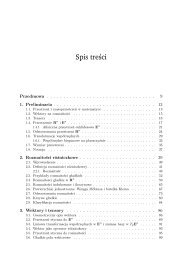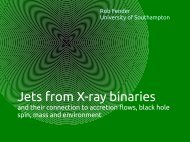X-ray Observations of Large Scale Jets in AGN
X-ray Observations of Large Scale Jets in AGN
X-ray Observations of Large Scale Jets in AGN
- No tags were found...
You also want an ePaper? Increase the reach of your titles
YUMPU automatically turns print PDFs into web optimized ePapers that Google loves.
X-<strong>ray</strong> <strong>Observations</strong> <strong>of</strong> <strong>Large</strong><strong>Scale</strong> <strong>Jets</strong> <strong>in</strong> <strong>AGN</strong>D. E. Harris, SAOCollaborators:H. Krawczynski, C. Cheung, S. Jester, M. HardcastleE. Perlman, J. Biretta, A. Siemig<strong>in</strong>owska, H. Marshall,D. Schwartz, plus many others
outl<strong>in</strong>e• Part I: Introduction – Short Review <strong>of</strong>current situation.• Part II: Difficulties for application <strong>of</strong>physics• Part III: Jet Structurehotspots, cont<strong>in</strong>uous, and knotsKrakow - 2006 June 27
CREDO -1( a personal perspective)• Sync. emission is hopelessly mired <strong>in</strong> theuncerta<strong>in</strong>ty <strong>of</strong> the value <strong>of</strong> B: total E; pressure;halflife, etc. Very tenuous passage to N(E)• IC/CMB is not much better because Γ isuncerta<strong>in</strong>. Throughout this talk I use lower caseγ for the Lorentz factor <strong>of</strong> the radiat<strong>in</strong>g electronsand upper case Γ for the bulk Lorentz factor <strong>of</strong>the jet. δ is the Doppler beam<strong>in</strong>g factor.Krakow - 2006 June 27
Electron Halflives• τ = 10 13 yearsγ {B´2+ 40(1+z) 4 Γ 2 }• for Synchrotron; X-<strong>ray</strong> frequencies <strong>of</strong> 10 18 Hz,γ= 0.0005 √[ν(1+z)/B(1)] ≈ 10 7 ,and τ is <strong>of</strong> order a year.IC/CMB with Γ > 5 (<strong>of</strong>ten >10)γ={ 2x10 -6 / Γ } √ν and for ν=10 18 , γ ≈ 100and τ ≥ 10 5 yearsKrakow - 2006 June 27
CREDO -2The X-<strong>ray</strong> Emission Process forQuasar <strong>Jets</strong>• Whereas there is little debate about radio andoptical for both FRI and quasar jets, there is noconcensus for the X-<strong>ray</strong>s from quasars and FRIIradio galaxies.• SYNC with γ ≈ 10 7 and halflife ≈ 1 year (like FRI);OR• IC/CMB with γ ≈ 100 and halflife ≥ 100,000 yearsKrakow - 2006 June 27
X-<strong>ray</strong> Emission from <strong>Jets</strong>is a “W<strong>in</strong>-W<strong>in</strong>” Game• Either we get <strong>in</strong>fo about the very top end <strong>of</strong> therelativistic electron spectrum, N(E),• OR we learn about the very bottom end!• ******************************************************• NEITHER END IS ACCESSABLEBY OTHER MEANS******************************************************• and now for the bad news…..we don’t know which end we are look<strong>in</strong>g at!Krakow - 2006 June 27
CREDO - 3• essentially all X-<strong>ray</strong> jets are s<strong>in</strong>gle sided;hence the Γ,δ [<strong>of</strong> the emitt<strong>in</strong>g plasmas]are <strong>of</strong> order a few or greater.• The emitt<strong>in</strong>g plasmas consist <strong>of</strong> relativistic(“hot”) electrons, but the “fluid” responsiblefor the energy flow consists <strong>of</strong> cold pairs,normal plasma (p + e), or Poynt<strong>in</strong>g flux.Krakow - 2006 June 27
Part II: Difficulties <strong>of</strong> apply<strong>in</strong>g thephysics• We want to obta<strong>in</strong> the parameters <strong>of</strong> theemitt<strong>in</strong>g regions….the exponent <strong>of</strong> thepower law describ<strong>in</strong>g N(E); breakenergies; cut<strong>of</strong>f energies; B field strength;beam<strong>in</strong>g factor, θ, & Γ. Plus all thederived quantities like energy content,pressure, etc.Krakow - 2006 June 27
Synchrotron Assumptions• is a valid concept; usually B eq• Emitt<strong>in</strong>g volume is same for all wavebands• SED is concave downwards, with cut<strong>of</strong>fs.• fill<strong>in</strong>g factor~1 (as opposed to filaments <strong>of</strong>high B with particles both between andwith<strong>in</strong> the filaments )Krakow - 2006 June 27
IC/CMB assumptions• s<strong>in</strong>gle emitt<strong>in</strong>g volume conta<strong>in</strong><strong>in</strong>g a s<strong>in</strong>glePL extend<strong>in</strong>g from circa γ=50 to γ=500000• Γ is large enough to produce obs. X-<strong>ray</strong>s• B eqrequired to pass from radio to N(E)• p=2α r+1 is the exponent <strong>of</strong> lower part <strong>of</strong>N(E), as well as <strong>of</strong> the ‘observed’ part.Krakow - 2006 June 27
The next image……• shows the extent <strong>of</strong> the extrapolation (<strong>in</strong>frequency, or, top axis, electron Lorentzfactor) between the observed segment <strong>of</strong>the spectrum <strong>of</strong> a knot <strong>in</strong> a jet, and thesegment responsible for the X-<strong>ray</strong>emission for the IC/CMB process.• It also demonstrates that new radiotelescopes under development will help totest this extrapolation.Krakow - 2006 June 27
PKS 0637 – Quasar with JetKrakow - 2006 June 27
Emitt<strong>in</strong>g Volumes: 3C 273• We want to constructSED’s for several bits<strong>of</strong> a jet. We constructphotometric regionsbased ma<strong>in</strong>ly on theX-<strong>ray</strong> morphology.• But when we use thesame regions foroptical and radio…Krakow - 2006 June 27
…the emitt<strong>in</strong>g volumes may notactually be the same size as for the• we have to assumethey are the same ifwe don’t have thesame resolution.X-<strong>ray</strong>sKrakow - 2006 June 27
4C 19.44: global X/radiocorrespondence is good; however,<strong>in</strong> detail, this is not the case.Krakow - 2006 June 27
Emitt<strong>in</strong>g Volume:Multi zone models:• La<strong>in</strong>g and Bridle have modeled some FRIjets and argue for the necessity <strong>of</strong> velocitystructure across the jet• Celotti and others have suggested a fast(Γ>10) sp<strong>in</strong>e plus slower sheath on kpcscales.• Uchiyama (poster #49) and Jester et al.f<strong>in</strong>d that a s<strong>in</strong>gle zone is <strong>in</strong>adequate forthe SED <strong>of</strong> parts <strong>of</strong> the 3C273 jet.Krakow - 2006 June 27
Emitt<strong>in</strong>g Volumes:Multizone ModelsThis permits more latitude for adequatelyfitt<strong>in</strong>g SED’s, but any 2 zone modelnormally precludes the critical testsafforded by comparison <strong>of</strong> radio, optical,and X-<strong>ray</strong> data.Krakow - 2006 June 27
Emitt<strong>in</strong>g volumes: Mavericks• While there isgenerally goodcorrespondencebetween bands, sometimes we f<strong>in</strong>d notableexceptions.• Here we see the radio(color) deviat<strong>in</strong>g fromthe X-<strong>ray</strong> (contours).Krakow - 2006 June 27
In the next slide…..• Note the prom<strong>in</strong>ent X-<strong>ray</strong> emission beyondknot C where the radio contours show ak<strong>in</strong>k to the north. In the bottom panel, wesee the hardness ratio for this featurediffers from that <strong>of</strong> knots B and C.Krakow - 2006 June 27
Krakow - 2006 June 27
PART III: Features• Hotspots• Cont<strong>in</strong>uous emission between knots• KnotsKrakow - 2006 June 27
Dist<strong>in</strong>guish<strong>in</strong>g Hotspots from Knots• Term<strong>in</strong>al HS where jetstops, but is emissionalways isotropic?• ‘Classically’ SSC expla<strong>in</strong>sthe X-<strong>ray</strong>s, but thereappears to be additionalemission.• 3C351: at least a factor <strong>of</strong>25 between1.4 GHzpower <strong>of</strong> N and S HS’s.• Hardcastle will discuss onFriday.Krakow - 2006 June 27
Cont<strong>in</strong>uous Emission between theknots• If synchrotron, requires distributedacceleration (e.g. magnetic acceleration orboundary layer shear acceleration, ref: ourhosts at this meet<strong>in</strong>g)• Could be underly<strong>in</strong>g IC/CMB component.• In either case we might expect α xto varybetween knots and <strong>in</strong>ter-knot regions.Current evidence does not support this.Krakow - 2006 June 27
Inter-knot X-<strong>ray</strong> emission <strong>in</strong> M87Krakow - 2006 June 27
PKS 1127 @ z=1.1: most <strong>of</strong> the X-<strong>ray</strong> emission <strong>of</strong> the <strong>in</strong>ner jet is notassociated with bright radio.Krakow - 2006 June 27
Cen A: another example <strong>of</strong>distributed X-<strong>ray</strong> emission, notalways associated with radio knots.Krakow - 2006 June 27
Conventional knots:shock acceleration• Downstream from the shock, we expect to‘loose’ the highest energy electronssooner than the lower energies and weassume that we can use distance from theshock as an ‘age’ <strong>in</strong>dicator.• Sync: X-<strong>ray</strong> brightness should drop fasterthan radio.• IC/CMB: opt. & rad. should drop fasterthan X-<strong>ray</strong>Krakow - 2006 June 27
Alternatives to Shocks for Knots• CHANGE OF DOPPLER FACTOR:• from change <strong>of</strong> Γ (unlikely), or• from change <strong>of</strong> θ (e.g. helical trajectories)• ‘BURST’ TYPE EJECTION FROM SMBH.• CONTRACTION - EXPANSION (i.e. notnecessarily <strong>in</strong> a shock)Krakow - 2006 June 27
EXPANSION LOSSES• SYNCHROTRON• all electrons lose samefractional E• emissivity drops ∝B 2• N(E) is smaller for fixedobserv<strong>in</strong>g band.• there are 3 effectsreduc<strong>in</strong>g theemissivity!• INVERSE COMPTON• all electrons lose samefractional E• [u(ν) drops for SSC]• for IC/CMB, thereis only onecontribution todecay.Krakow - 2006 June 27
Compression/Expansion forsynchrotron emission with a fixedobserv<strong>in</strong>g band.Krakow - 2006 June 27
Knots from curved trajectory• Enhanced emissivity could arise from achange <strong>in</strong> the beam<strong>in</strong>g factor.• The larger Γ required for IC/CMB modelsmeans that Q should have higher contrastknots than FRIs s<strong>in</strong>ce the emission cone issmaller for larger Γ.Krakow - 2006 June 27
? – What path does the fluid follow• Straight l<strong>in</strong>e(‘ballistic’) ?• Helical ?• NB: a curvedtrajectory withbeam<strong>in</strong>g is a goodway to expla<strong>in</strong> theoccurrence <strong>of</strong> knots.It also relaxesconstra<strong>in</strong>ts on thejet angle to the l.o.s.Krakow - 2006 June 27
Digression: Sizes & Lum<strong>in</strong>ositiesGRB, μQ, FRI, FRII+Q jets are all verypretty; be<strong>in</strong>g long and narrow….. but theyare <strong>of</strong> vastly different scales! Don’t expectidentical physics!Krakow - 2006 June 27
Relative sizes.microQ and M87Krakow - 2006 June 27
3C273 at same brightness scale asM87jet outside the galaxyM87 jet with<strong>in</strong> galaxyKrakow - 2006 June 27
Compare 3C 273 with M87:Parameters for a bright knot3C 273• 0.5” ≈ 1300pc• L x≈ 10 43 ergs/s• B x≈ 0.27 evps/0.05”p• α x≤ 1M87• 0.5” ≈ 38pc• L x≈ 10 41 ergs/s• B x≈ 5.5 evps/0.05”p• α x≥ 1Krakow - 2006 June 27
3C 273 compared to PKS1127 @z=1.1Krakow - 2006 June 27
Or all together for a s<strong>in</strong>gle view:Krakow - 2006 June 27
Comparative Sizes: log scale(miss<strong>in</strong>g from this plot are typical VLBI extragalactic jets)Krakow - 2006 June 27
Projected vs. Physical Lengthvia ‘best guess’ θKrakow - 2006 June 27
M87 as an example <strong>of</strong> synchrotron• Offsets – compar<strong>in</strong>g radio contours on an X-<strong>ray</strong>imageKrakow - 2006 June 27
Morphology: X-<strong>ray</strong> & Radio• X-<strong>ray</strong> peaks upstream <strong>of</strong> radio <strong>in</strong> knots D & FKrakow - 2006 June 27
Projections• - radio• optical• X-<strong>ray</strong>Krakow - 2006 June 27
M87 Spectral Changes• Downstream from the core region, andalso from knot A, the X-<strong>ray</strong> spectrums<strong>of</strong>tens.• The next slide shows the X-<strong>ray</strong> jet <strong>in</strong> 3 X-<strong>ray</strong> bands, with brightness labels.Krakow - 2006 June 27
Flux maps: 3 bandsKrakow - 2006 June 27
Offsets <strong>in</strong> 3C 273 and PKS1127• In a sense, these sort <strong>of</strong> <strong>of</strong>fsets seem tobe scale <strong>in</strong>variant s<strong>in</strong>ce we see similarproperties for these powerful sources, buton a larger scale.Krakow - 2006 June 27
3C273 <strong>of</strong>fsetsKrakow - 2006 June 27
PKS 1127 <strong>of</strong>fsetsKrakow - 2006 June 27
<strong>of</strong>fsets & progressions=2 sides <strong>of</strong>same co<strong>in</strong>• If we were view<strong>in</strong>g 3C273 at z=1.1, the jetwould be unresolved, but there would be avery obvious <strong>of</strong>fset between peakbrightnesses: X-<strong>ray</strong> peak<strong>in</strong>g closer to thequasar; optical and radio progressivelyfurther downstream.• i.e. the <strong>in</strong>ternal (unresolved) structure <strong>of</strong> aknot <strong>of</strong> PKS1127 could look like this…..Krakow - 2006 June 27
3C273: X, Opt, & RadioKrakow - 2006 June 27
Variability• In addition to M87, variability is also seen<strong>in</strong> features <strong>of</strong> Cen A (Kraft et al.)• The knots <strong>of</strong> powerful Q are generally toolarge physically for this test.Krakow - 2006 June 27
Project: 4 years <strong>of</strong> monitor<strong>in</strong>gthe M87 jet with Chandra• The Nucleus varies,as expected.• HST-1 varies andhas peaked at 50x the2000Jul level.• knot D probablyvaries.• knot A shows a milddecay.Krakow - 2006 June 27
HST-1 LightcurvesKrakow - 2006 June 27
Decay Time• X-<strong>ray</strong>: suspect that τ(sync)
VLBA dataKrakow - 2006 June 27
What we f<strong>in</strong>d…2.8c apparentproper motionKrakow - 2006 June 27
Krakow - 2006 June 27
1994-1998; same th<strong>in</strong>g but opticalKrakow - 2006 June 27
Superlum<strong>in</strong>al optical featuresKrakow - 2006 June 27
Parameters for components• 1994-1998 optical• nucleus->hst-1: 0.87’’• β(lead<strong>in</strong>g): 0.84±0.1• β(follow<strong>in</strong>g): 4 to 6• size: ≤ 4pc• overall size: 24pc• 2005 radio• nucleus->hst-1: 0.86”• β(lead<strong>in</strong>g): 1.0±0.1• β(follow<strong>in</strong>g): 2.8• size: 10mas or 0.7pc(expected 1mas, 0.1pc)• overall size: 3pc• date when follow<strong>in</strong>g wasat lead<strong>in</strong>g: 2001 SepKrakow - 2006 June 27
The Red Queen’s RaceThe upstream edge <strong>of</strong> HST-1 appears tobe mov<strong>in</strong>g away from the core with avelocity close to c; yet 10 years later, ithas not advanced.Krakow - 2006 June 27
FINKrakow - 2006 June 27










